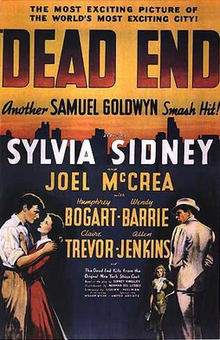William Wyler’s version of Sidney Kingsley’s acclaimed social drama about New York slums and juvenile delinquency was considered significant in the context of the Depression, when it was made.
| Dead End | |
|---|---|

Theatrical release poster
|
|
| Language | English |
| Budget | $900,000 (es |
However, the movie has not held up well and it is not as interesting as later Wyler movies that were also based on plays (The Children’s Hour).
Humphrey Bogart plays Baby Face Martin, who returns to his old neighborhood after a decade of a criminal career. Disguised by a plastic surgery Martin wishes to see his mother (Marjorie Main) and his sweetheart (Claire Trevor). Socializing with the “Dead End Kids,” and teaching them tricks of the trade has a negative influence on the community and proves to be upsetting to some of the more respectable residents.
Martin is contrasted with Dave (Joel McCrea), a decent guy and unsuccessful architect who’s struggling to improve on his lot and get out of the slum,
He is torn in his love for two very different women, Drina (Sylvia Sydney), the poor, good-hearted girl and Kay (Wendy Barry), the rich girl who lives in a luxury building close to the ghetto.
The acting is excellent, particularly by Bogart in his pre-stardom era, in a year in which he also excelled as Duke Mantee in the Bette Davis melodrama, “The Petrified Forest.”
Bogart would become a star in 1941, as a result of appearing in John Huston’s superb crime drama, The Maltese Falcon.
Cast:
Drina (Sylvia Sydney)
Dave (Joel McCrea)
Baby Face Martin (Humphrey Bogart)
Kay (Wendy Barrie)
Francie (Claire Trevor)
Hunk (Allen Jenkins)
Mrs. Martin (Marjorie Main)
Tommy (Billy Halop)
Dippy (Huntz Hall)
Angel (Bobby Jordan)
Credits
Directed by William Wyler
Screenplay by Lillian Hellman, based on Dead End, 1935 play by Sidney Kingsley
Produced by Samuel Goldwyn
Cinematography Gregg Toland
Edited by Daniel Mandell
Music by Alfred Newman
Costume: Omar Kiam
Production company: Samuel Goldwyn Productions
Distributed by United Artists
Release date: August 27, 1937 (U.S.)
Running time: 93 minutes
Oscar Nominations: 4
Picture, produced by Samuel Goldwyn, with Merritt Hulburd
Supporting Actress: Claire Trevor
Cinematography: Gregg Toland
Interior Decoration: Richard Day
Oscar Awards: None
Oscar Context
In 1937, nine other movies competed with “Dead End” for Best Picture, including Warner biopic, “The Life of Emile Zola,” which won, Leo McCarey’s marital comedy “The Awful Truth” with six nominations, and Gregory La Cava’s backstage drama, “Stage Door,” with four.
The other nominees were: William Wyler’s social drama set in a New York City slum, “Dead End,” Frank Capra’s utopian comedy “Lost Horizon,” and Henry King’s adventure “In Old Chicago,” The first version of “A Star Is Born,” “The Good Earth,” “In Old Chicago,” and the Deana Durbin vehicle, “One Hundred Men and a Girl.”
Next to “Life of Emile Zola,” the most-nominated films were Fox’s adventure “In Old Chicago” and “A Star Is Born.” Only one of the ten nominated pictures was a comedy, Leo McCarey’s sublime screwball, “The Awful Truth,” co-starring Cary Grant and Irene Dunne at their very best.
The Oscars were spread among eight films; the only two pictures that didn’t win any award were “Dead End” and “Stage Door.”
Claire Trevor received her first Supporting Actress nomination, and she would win the Oscar in that category in 1948, for “Key Largo,” and would score one more nomination, in 1954 for “The High and the Mighty.” The brilliant lenser Gregg Toland lost the Oscar to Karl Freund (“The Good Earth”).










